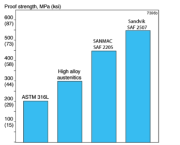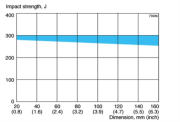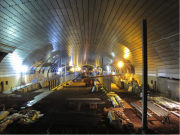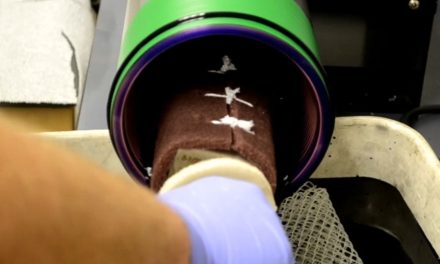Faced with the major task of constructing the Holmestrand station, part of a new high-speed rail system which is transforming Norway’s transport infrastructure, the project’s lead engineering company approached Sandvik Materials Technology to lend its support and advanced duplex stainless steel to a new design innovation.
In 2010, Norway’s national railway authority began construction of a groundbreaking high-speed rail project intended to revolutionize the country’s transport infrastructure. Located in the town of Holmestrand in Vestfold, on Norway’s south-eastern coast, the project would center around a new high-speed rail station and entailed creating a whole new infrastructure capable of supporting faster train speeds than ever before.
The Holmestrand station plans formed part of a 12 km tunnel cut through a mountain. The tunnel was required to allow multiple trains to pass one another at speeds of up to 250 kilometers per hour (km/hr), something which had never been achieved previously.
Trains travelling at high speeds can generate high forces of pressure, noise and winds which may even prove destructive in some cases, against doors for example, and create noise levels that are unbearable to bystanders. It is for this reason that railway lines and stations are usually built outdoors and some distance away from town centers.
This was not the case with the Holmestrand project, for which the rail network’s existing line was to be moved 150 meters inland with the new station built closer to the town center.
The extreme forces of the 250 km/h trains would also be intensified within the enclosed space of the mountain tunnel, and designs for the construction specified that only 400 meters of the railway tracks’ 14 km total length were to be situated outdoors. Meanwhile, passengers would stand waiting for the speeding trains just a few meters away. It was clear that extreme resilience was required from the new station infrastructure, around-the-clock.
Design solution
A number of organizations would collaborate to realize the Holmestrand construction. In charge of the overall engineering was Ramboll, the Danish engineering, design and consultancy company that brought its own extensive pedigree in tunnel engineering to the project.
Ramboll enlisted Hollandia Structures BV to oversee the detail engineering, a Dutch structural steel and mechanical engineering contractor responsible for such high-profile projects as the London Eye.
After the tunnel had been drilled by another enlisted company, it fell to Ramboll to devise how the station and tunnel could best withstand the forces generated by excessive 250km/hr train speeds. These forces would be absorbed and dissipated by the Holmestrand buildings and infrastructure, and also tempered by specially designed pressure-effected sluice doors.
Ramboll’s solution was a design concept whereby the ceilings of the tunnel, unevenly formed by the blasted rock, were to be clad in approximately 200 mm of cement. From the cement layer would hang four layers of beams including main beams, aluminum beams, and beams designed specifically to absorb sound.
Crucially, the beams were to be suspended from around 700 innovative ‘hanger’ components based on an entirely new and ground-breaking design.
New innovation
It was in the development of the innovative hanger components that Sandvik Materials Technology’s support and consultancy in the latest advanced materials, including stainless steels, would prove essential.
Requirements placed on the hangers included that they be strong enough to bear operational loads, yet light and flexible enough to respond to the pressures and movements exerted upon them. All of the 700 hangers would also be required to last for up to 100 years with minimal maintenance.
An initial design concept had explored the idea of static hangers made from plate. Yet it was soon determined that an improved concept was needed, whereby the hangers could be adjustable and easy to service and maintain – and the choice of material for the hangers would prove crucial to this.
Duplex stainless steel
After consideration, duplex stainless steel was identified as the most suitable choice for the hanger components. Duplex grades offer excellent resistance to corrosion combined with very high mechanical strength. This contributes towards significantly more uptime in service, especially compared with carbon steels and conventional stainless steels.
Initially, Ramboll was unsure as to whether it would be possible to manufacture the innovative hanger components. It consulted Hollandia and the search for a production partner began.
Based on the cruciality of the choice material, and also the required accuracy of engineering, Sandvik was eventually chosen as the supplier. After some consultation, the manufacturer’s Sanmac 2205 duplex stainless steel was identified as a suitable material for the hangers, to be supplied as hollow bar, see Figure 1.

Sanmac 2205 duplex stainless steel is imbued with a number of characteristics that would be ideal for the demanding operating conditions within the Holmestrand station and tunnel. These include enhanced corrosion resistance and physical properties, and also its mechanical strength which allows for lighter constructions, more compact system designs and reduced welding.
On the choice of material, Viktor Stefansson, Global Product Manager for Hollow Bar at Sandvik, says: “Sandvik Sanmac 2205 duplex stainless steel is a perfect grade where a material with high corrosion and fatigue resistance, and high mechanical strength is required that could also provide excellent machinability. Duplex stainless steel is unbeatable if you need these properties.”
Partnership and support
The duplex stainless steel hanger components would play a fundamental and underpinning role in supporting the tunnel infrastructure, enabling it to resist and redirect forces generated by the high-speed passing trains.
Yet the components were not only crucial from an engineering perspective. Because the rest of the structure would be suspended from the hangers, construction work on the station itself could not proceed until these parts were mounted. As the supplier of the chosen duplex stainless steel, Sandvik therefore helped to control the logistics planning for the tunnel to a very tight schedule.
Hollandia was responsible for fabrication and erection of the steel. Jan Beckers, Managing Director of Hollandia, comments: “When Sandvik came into the picture, they showed craftsmanship and were trustworthy, being the right partner.”
Figure 2 shows the hangers, installed and suspended from the cement-lined ceiling.

Sanmac 2205 has stable microstructural properties which imbue the material with good impact strength, both at room temperature and low temperatures.
The material’s fatigue resistant capabilities are already proven in the types of demanding application for which it was initially designed – e.g. as heat exchanger tubing in refineries where operational temperatures exceed 280°C (540°F) over long periods. Based on this, the duplex stainless steel could be depended upon to retain its properties over long periods in the Holmestrand tunnel.
The positioning of the hangers for supporting the tunnel’s infrastructural beams are shown during construction of the station in Figure 3.

Corrosion resistance
When selecting the material for the hanger components, the specifiers had to be sure that the chosen steel would provide the required corrosion resistance properties. Installed between the mountain wall and the tunnel interior, the hollow bar components would provide a critical role in supporting the surrounding elements.
Data from extensive corrosion testing shows that Sanmac 2205 stainless steel possesses better resistance to general corrosion in most media than steels of types ASTM 316L and ASTM 316L. Testing also found Sanmac 2205 to have superior resistance to stress corrosion cracking (SCC), see Figure 4.

Sanmac 2205 exhibits strong resistance to pitting and crevice corrosion, intergranular corrosion – due largely to its low carbon content – and erosion corrosion. Sanmac 2205 also has higher strength than 316/316L austenitic stainless steels and is therefore better able to resist corrosion fatigue over the long term.
Mechanical properties
The mechanical properties of Sanmac 2205 were especially important at Holmestrand because the project required an alloy that is able to cope with extreme conditions and forces, some of which are not yet well profiled or documented. Table 1 shows the mechanical properties of Sanmac 2205 in the solution annealed and quenched condition. (Bar of sizes above 260 mm may have values slightly lower than those shown.)

Figure 5 shows how the proof strength of Sanmac 2205 (again in the solution annealed and quenched condition) compares with other grades, including high alloy austenitic stainless steels.
 It is clear that Sanmac 2205 exhibits good impact strength, both at room temperature and low temperatures. Figure 6 presents typical impact energy values for Sanmac 2205 in different sizes at -50 °C (-58 °F). These values apply for standard Charpy-V specimens, which are 10 x 10 mm / 0.39 x 0.39 in, taken in the longitudinal direction of the bar. While impact strength is lower for dimensions above 260 mm (10.2 in), the Sandvik Sanmac 2205 bar stock program can guarantee an impact strength of 70 J (52 ft lb) at -50 °C (-58 °F) for sizes up to 260 mm (10.2 in).
It is clear that Sanmac 2205 exhibits good impact strength, both at room temperature and low temperatures. Figure 6 presents typical impact energy values for Sanmac 2205 in different sizes at -50 °C (-58 °F). These values apply for standard Charpy-V specimens, which are 10 x 10 mm / 0.39 x 0.39 in, taken in the longitudinal direction of the bar. While impact strength is lower for dimensions above 260 mm (10.2 in), the Sandvik Sanmac 2205 bar stock program can guarantee an impact strength of 70 J (52 ft lb) at -50 °C (-58 °F) for sizes up to 260 mm (10.2 in).

Designing a new steel component
The need to optimize the hangar components resulted in and innovation with Sandvik’s close involvement, in the form of an entirely new hollow bar component design. The final hanger component is shown in Figure 7, designed to be easily adjustable, and easy to service and maintain, and responsive to the extreme forces within the Holmestrand tunnel.

The application of the hanger components also required that they be covered by aluminum plates and installed with tolerances of +/- 15mm at all ceiling points. For this purpose, Sanmac hollow bar has a good finish, dimensions and tolerances (Outside diameter +2 / -0 %, but minimum +1 / -0 mm; inside diameter +0 / -2 %, but minimum +0 / -1 mm; straightness +/-1.5mm/m) including after machining.
Aside from safety, the properties of Sanmac 2205 are advantageous from a design and fabrication perspective. For example, the material has a lower coefficient of thermal expansion than austenitic stainless steels, see Figure 8, and very good machining properties. In design processes, this can significantly reduce compromise in terms of corrosion resistance and mechanical strength.

The machining capabilities of Sanmac 2205 were necessary during the Holmestrand construction, and it exhibited good working properties. The machining company said it did not experience any problems with turning of the material.
Through all of these properties the application of Sanmac 2205 proved successful in realizing the new hanger design. Fabrication was completed safe in the knowledge that the alloy would still perform to the expected high standards and specifications.
Reduced lead times
As mentioned, Sandvik’s support was also integral to the Holmestrand project went beyond supply of the hollow bar product itself. Its partnership included recommending improved dimensions for the Sanmac® 2205 hanger components in order to guarantee optimal use of the material. This saved Hollandia more than 100 tonnes of material. Sandvik was able to supply the components cut to length and on time according to a tight schedule.
Dyon Hermsen, Dutch Area Sales Area Manager, Sandvik, who worked closely with the customer, agrees the project could not have been completed on time without Sandvik’s support.
“Hollandia chose Sandvik because they felt we could help achieve the tight delivery times specified for their performance, as a trusted partner we had seven weeks from order to delivery. As the construction was one of the first activities before continuing with the station, Sandvik’s hollow bar had the highest prioritization.
“There was no room for mistakes so we had the whole chain – R&D, planning and production – with us.”
Conclusions
In the end, production and installation of the new hangers proved to be straightforward and efficient. Sanmac 2205 stainless steel was successfully applied and found to be entirely fit for the purpose in realizing Ramboll’s design for the hangers.
An important result was that tolerances of +/- 15mm were achieved at all points, despite the variations in height of the blasted rock tunnel ceiling. In total, nearly 700 hangers were installed on site, of which only one had to be taken down due to casting issues.

Overall, the duplex stainless steel hangers are proven to be sufficiently flexible and adjustable to cope with the challenging environment. Sandvik therefore anticipates future projects for its duplex stainless steel hollow bar, going forward.
Meanwhile, the Holmestrand tunnel and station opened in November 2016. Not only is it impressive feat in terms of engineering and construction, the station is already living up to its promise of transforming Norway’s transport infrastructure.
For more information on Sandvik, visit http://www.materials.sandvik.com

